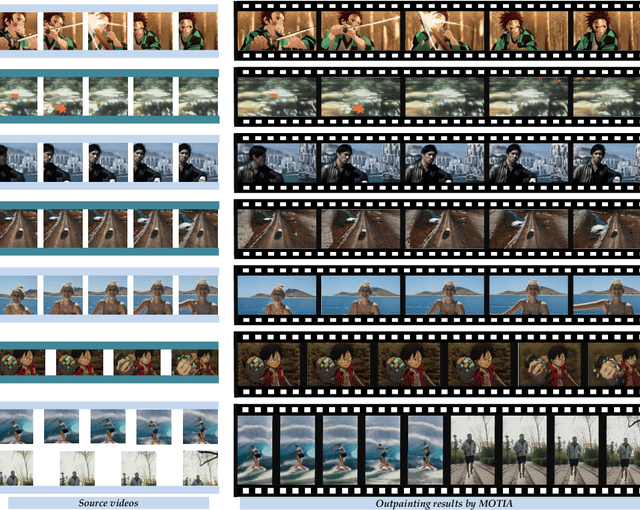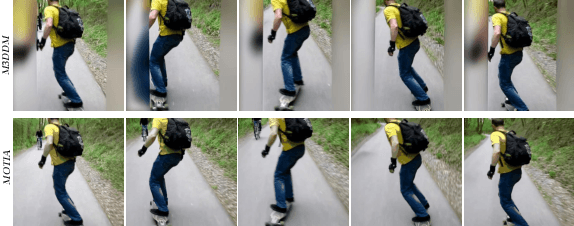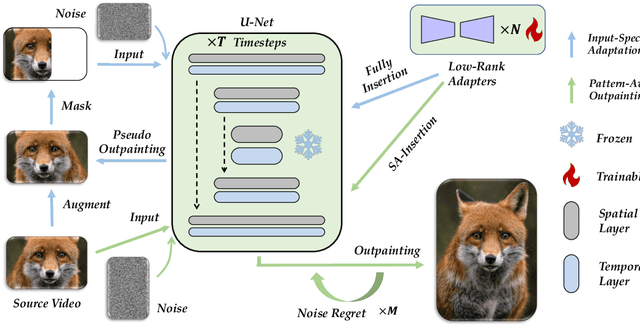Zhaoyang Huang
CoProSketch: Controllable and Progressive Sketch Generation with Diffusion Model
Apr 11, 2025Abstract:Sketches serve as fundamental blueprints in artistic creation because sketch editing is easier and more intuitive than pixel-level RGB image editing for painting artists, yet sketch generation remains unexplored despite advancements in generative models. We propose a novel framework CoProSketch, providing prominent controllability and details for sketch generation with diffusion models. A straightforward method is fine-tuning a pretrained image generation diffusion model with binarized sketch images. However, we find that the diffusion models fail to generate clear binary images, which makes the produced sketches chaotic. We thus propose to represent the sketches by unsigned distance field (UDF), which is continuous and can be easily decoded to sketches through a lightweight network. With CoProSketch, users generate a rough sketch from a bounding box and a text prompt. The rough sketch can be manually edited and fed back into the model for iterative refinement and will be decoded to a detailed sketch as the final result. Additionally, we curate the first large-scale text-sketch paired dataset as the training data. Experiments demonstrate superior semantic consistency and controllability over baselines, offering a practical solution for integrating user feedback into generative workflows.
GS-DiT: Advancing Video Generation with Pseudo 4D Gaussian Fields through Efficient Dense 3D Point Tracking
Jan 05, 2025



Abstract:4D video control is essential in video generation as it enables the use of sophisticated lens techniques, such as multi-camera shooting and dolly zoom, which are currently unsupported by existing methods. Training a video Diffusion Transformer (DiT) directly to control 4D content requires expensive multi-view videos. Inspired by Monocular Dynamic novel View Synthesis (MDVS) that optimizes a 4D representation and renders videos according to different 4D elements, such as camera pose and object motion editing, we bring pseudo 4D Gaussian fields to video generation. Specifically, we propose a novel framework that constructs a pseudo 4D Gaussian field with dense 3D point tracking and renders the Gaussian field for all video frames. Then we finetune a pretrained DiT to generate videos following the guidance of the rendered video, dubbed as GS-DiT. To boost the training of the GS-DiT, we also propose an efficient Dense 3D Point Tracking (D3D-PT) method for the pseudo 4D Gaussian field construction. Our D3D-PT outperforms SpatialTracker, the state-of-the-art sparse 3D point tracking method, in accuracy and accelerates the inference speed by two orders of magnitude. During the inference stage, GS-DiT can generate videos with the same dynamic content while adhering to different camera parameters, addressing a significant limitation of current video generation models. GS-DiT demonstrates strong generalization capabilities and extends the 4D controllability of Gaussian splatting to video generation beyond just camera poses. It supports advanced cinematic effects through the manipulation of the Gaussian field and camera intrinsics, making it a powerful tool for creative video production. Demos are available at https://wkbian.github.io/Projects/GS-DiT/.
A Global Depth-Range-Free Multi-View Stereo Transformer Network with Pose Embedding
Nov 04, 2024



Abstract:In this paper, we propose a novel multi-view stereo (MVS) framework that gets rid of the depth range prior. Unlike recent prior-free MVS methods that work in a pair-wise manner, our method simultaneously considers all the source images. Specifically, we introduce a Multi-view Disparity Attention (MDA) module to aggregate long-range context information within and across multi-view images. Considering the asymmetry of the epipolar disparity flow, the key to our method lies in accurately modeling multi-view geometric constraints. We integrate pose embedding to encapsulate information such as multi-view camera poses, providing implicit geometric constraints for multi-view disparity feature fusion dominated by attention. Additionally, we construct corresponding hidden states for each source image due to significant differences in the observation quality of the same pixel in the reference frame across multiple source frames. We explicitly estimate the quality of the current pixel corresponding to sampled points on the epipolar line of the source image and dynamically update hidden states through the uncertainty estimation module. Extensive results on the DTU dataset and Tanks&Temple benchmark demonstrate the effectiveness of our method. The code is available at our project page: https://zju3dv.github.io/GD-PoseMVS/.
ETO:Efficient Transformer-based Local Feature Matching by Organizing Multiple Homography Hypotheses
Oct 31, 2024



Abstract:We tackle the efficiency problem of learning local feature matching. Recent advancements have given rise to purely CNN-based and transformer-based approaches, each augmented with deep learning techniques. While CNN-based methods often excel in matching speed, transformer-based methods tend to provide more accurate matches. We propose an efficient transformer-based network architecture for local feature matching. This technique is built on constructing multiple homography hypotheses to approximate the continuous correspondence in the real world and uni-directional cross-attention to accelerate the refinement. On the YFCC100M dataset, our matching accuracy is competitive with LoFTR, a state-of-the-art transformer-based architecture, while the inference speed is boosted to 4 times, even outperforming the CNN-based methods. Comprehensive evaluations on other open datasets such as Megadepth, ScanNet, and HPatches demonstrate our method's efficacy, highlighting its potential to significantly enhance a wide array of downstream applications.
BlinkVision: A Benchmark for Optical Flow, Scene Flow and Point Tracking Estimation using RGB Frames and Events
Oct 27, 2024Abstract:Recent advances in event-based vision suggest that these systems complement traditional cameras by providing continuous observation without frame rate limitations and a high dynamic range, making them well-suited for correspondence tasks such as optical flow and point tracking. However, there is still a lack of comprehensive benchmarks for correspondence tasks that include both event data and images. To address this gap, we propose BlinkVision, a large-scale and diverse benchmark with multiple modalities and dense correspondence annotations. BlinkVision offers several valuable features: 1) Rich modalities: It includes both event data and RGB images. 2) Extensive annotations: It provides dense per-pixel annotations covering optical flow, scene flow, and point tracking. 3) Large vocabulary: It contains 410 everyday categories, sharing common classes with popular 2D and 3D datasets like LVIS and ShapeNet. 4) Naturalistic: It delivers photorealistic data and covers various naturalistic factors, such as camera shake and deformation. BlinkVision enables extensive benchmarks on three types of correspondence tasks (optical flow, point tracking, and scene flow estimation) for both image-based and event-based methods, offering new observations, practices, and insights for future research. The benchmark website is https://www.blinkvision.net/.
Rectified Diffusion: Straightness Is Not Your Need in Rectified Flow
Oct 09, 2024Abstract:Diffusion models have greatly improved visual generation but are hindered by slow generation speed due to the computationally intensive nature of solving generative ODEs. Rectified flow, a widely recognized solution, improves generation speed by straightening the ODE path. Its key components include: 1) using the diffusion form of flow-matching, 2) employing $\boldsymbol v$-prediction, and 3) performing rectification (a.k.a. reflow). In this paper, we argue that the success of rectification primarily lies in using a pretrained diffusion model to obtain matched pairs of noise and samples, followed by retraining with these matched noise-sample pairs. Based on this, components 1) and 2) are unnecessary. Furthermore, we highlight that straightness is not an essential training target for rectification; rather, it is a specific case of flow-matching models. The more critical training target is to achieve a first-order approximate ODE path, which is inherently curved for models like DDPM and Sub-VP. Building on this insight, we propose Rectified Diffusion, which generalizes the design space and application scope of rectification to encompass the broader category of diffusion models, rather than being restricted to flow-matching models. We validate our method on Stable Diffusion v1-5 and Stable Diffusion XL. Our method not only greatly simplifies the training procedure of rectified flow-based previous works (e.g., InstaFlow) but also achieves superior performance with even lower training cost. Our code is available at https://github.com/G-U-N/Rectified-Diffusion.
BlinkTrack: Feature Tracking over 100 FPS via Events and Images
Sep 26, 2024Abstract:Feature tracking is crucial for, structure from motion (SFM), simultaneous localization and mapping (SLAM), object tracking and various computer vision tasks. Event cameras, known for their high temporal resolution and ability to capture asynchronous changes, have gained significant attention for their potential in feature tracking, especially in challenging conditions. However, event cameras lack the fine-grained texture information that conventional cameras provide, leading to error accumulation in tracking. To address this, we propose a novel framework, BlinkTrack, which integrates event data with RGB images for high-frequency feature tracking. Our method extends the traditional Kalman filter into a learning-based framework, utilizing differentiable Kalman filters in both event and image branches. This approach improves single-modality tracking, resolves ambiguities, and supports asynchronous data fusion. We also introduce new synthetic and augmented datasets to better evaluate our model. Experimental results indicate that BlinkTrack significantly outperforms existing event-based methods, exceeding 100 FPS with preprocessed event data and 80 FPS with multi-modality data.
Phased Consistency Model
May 28, 2024Abstract:The consistency model (CM) has recently made significant progress in accelerating the generation of diffusion models. However, its application to high-resolution, text-conditioned image generation in the latent space (a.k.a., LCM) remains unsatisfactory. In this paper, we identify three key flaws in the current design of LCM. We investigate the reasons behind these limitations and propose the Phased Consistency Model (PCM), which generalizes the design space and addresses all identified limitations. Our evaluations demonstrate that PCM significantly outperforms LCM across 1--16 step generation settings. While PCM is specifically designed for multi-step refinement, it achieves even superior or comparable 1-step generation results to previously state-of-the-art specifically designed 1-step methods. Furthermore, we show that PCM's methodology is versatile and applicable to video generation, enabling us to train the state-of-the-art few-step text-to-video generator. More details are available at https://g-u-n.github.io/projects/pcm/.
Deep Reward Supervisions for Tuning Text-to-Image Diffusion Models
May 01, 2024Abstract:Optimizing a text-to-image diffusion model with a given reward function is an important but underexplored research area. In this study, we propose Deep Reward Tuning (DRTune), an algorithm that directly supervises the final output image of a text-to-image diffusion model and back-propagates through the iterative sampling process to the input noise. We find that training earlier steps in the sampling process is crucial for low-level rewards, and deep supervision can be achieved efficiently and effectively by stopping the gradient of the denoising network input. DRTune is extensively evaluated on various reward models. It consistently outperforms other algorithms, particularly for low-level control signals, where all shallow supervision methods fail. Additionally, we fine-tune Stable Diffusion XL 1.0 (SDXL 1.0) model via DRTune to optimize Human Preference Score v2.1, resulting in the Favorable Diffusion XL 1.0 (FDXL 1.0) model. FDXL 1.0 significantly enhances image quality compared to SDXL 1.0 and reaches comparable quality compared with Midjourney v5.2.
Be-Your-Outpainter: Mastering Video Outpainting through Input-Specific Adaptation
Mar 20, 2024



Abstract:Video outpainting is a challenging task, aiming at generating video content outside the viewport of the input video while maintaining inter-frame and intra-frame consistency. Existing methods fall short in either generation quality or flexibility. We introduce MOTIA Mastering Video Outpainting Through Input-Specific Adaptation, a diffusion-based pipeline that leverages both the intrinsic data-specific patterns of the source video and the image/video generative prior for effective outpainting. MOTIA comprises two main phases: input-specific adaptation and pattern-aware outpainting. The input-specific adaptation phase involves conducting efficient and effective pseudo outpainting learning on the single-shot source video. This process encourages the model to identify and learn patterns within the source video, as well as bridging the gap between standard generative processes and outpainting. The subsequent phase, pattern-aware outpainting, is dedicated to the generalization of these learned patterns to generate outpainting outcomes. Additional strategies including spatial-aware insertion and noise travel are proposed to better leverage the diffusion model's generative prior and the acquired video patterns from source videos. Extensive evaluations underscore MOTIA's superiority, outperforming existing state-of-the-art methods in widely recognized benchmarks. Notably, these advancements are achieved without necessitating extensive, task-specific tuning.
 Add to Chrome
Add to Chrome Add to Firefox
Add to Firefox Add to Edge
Add to Edge